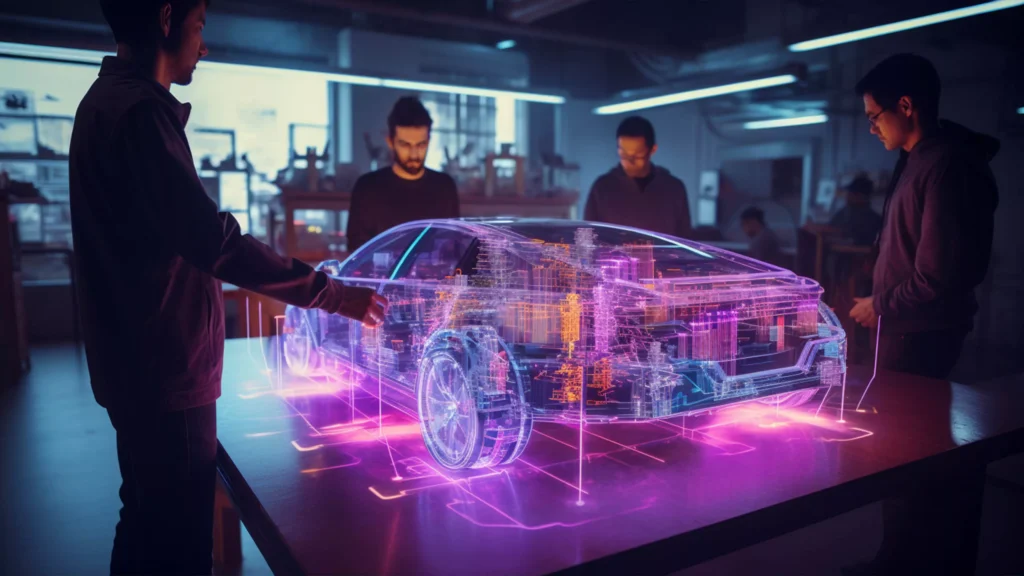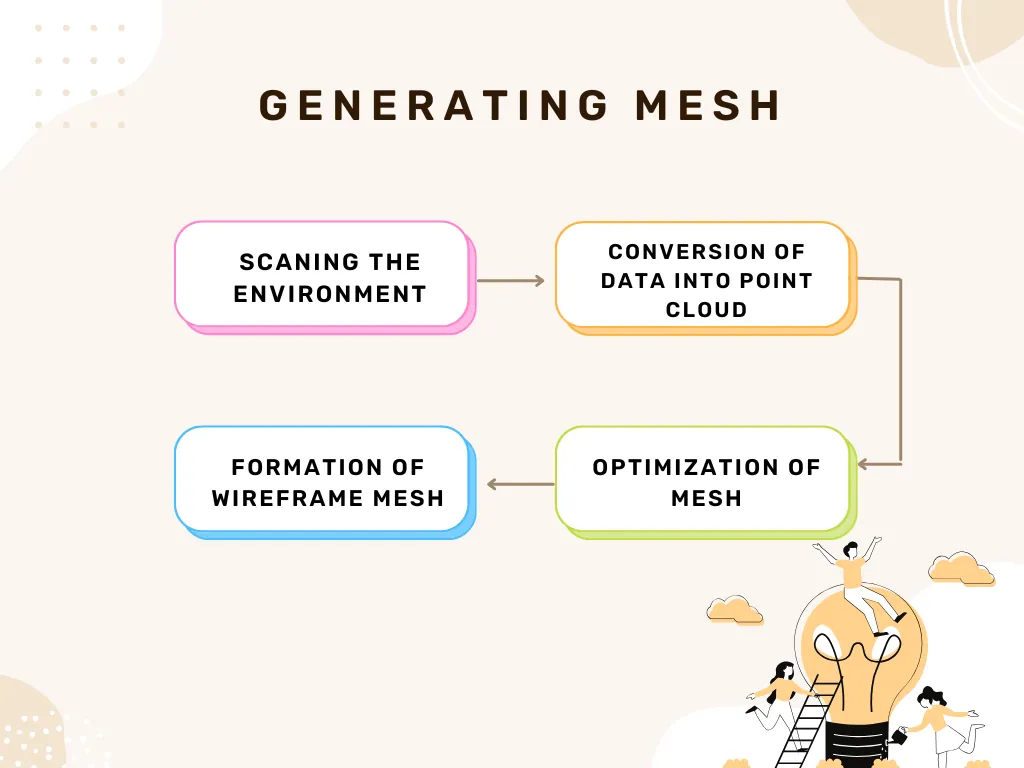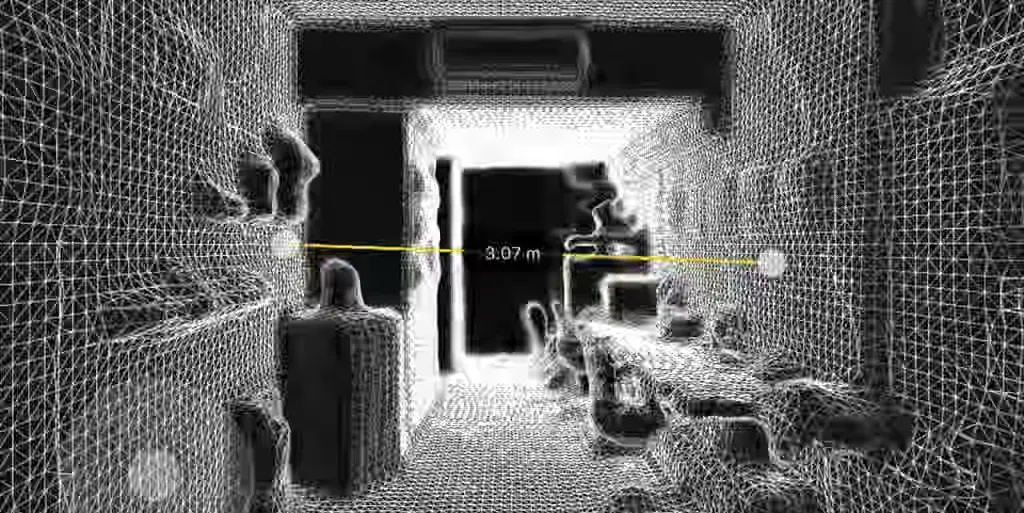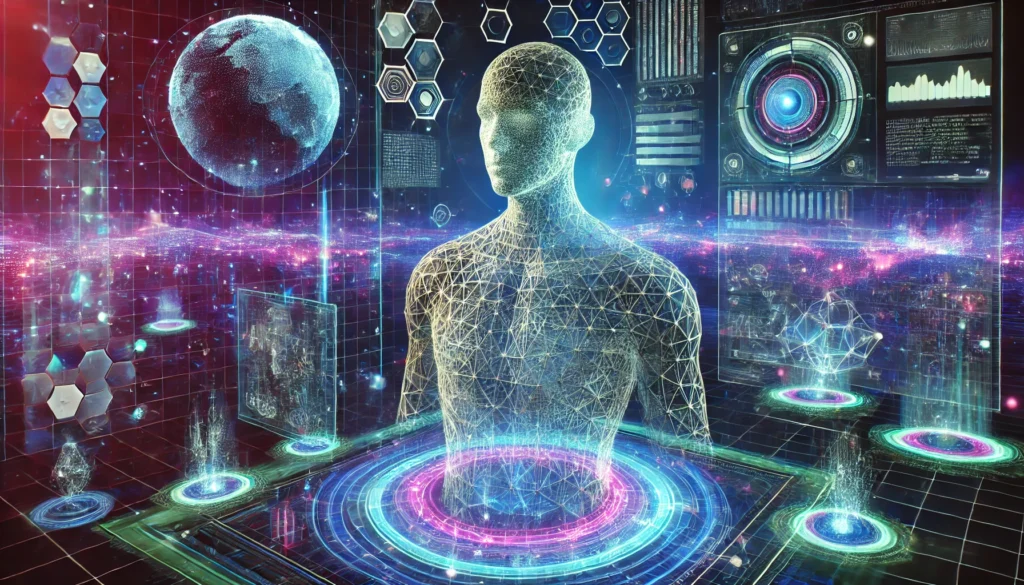
Have you ever thought about how AR objects stay on real surfaces or how VR worlds seem so real? The answer is Mesh Technology. This is the digital system that creates virtual environments. Microsoft HoloLens uses real-time spatial meshing to understand your surroundings, allowing holograms to interact with furniture or a digital pet to move around your room. This Technology is changing how we experience digital spaces, from realistic games to AR filters and holographic displays. But how does it work? Let’s explore!
What is Mesh?
This technology has multiple meanings across various industries including Literature, Engineering, Biology & Textiles. In general, it is a network of interconnected things forming a web-like structure. In the AR/VR field a mesh is the virtual representation of objects and environments, made up of interconnected points. It is the structural foundation for AR/VR applications.
How AR/VR Devices Generate Meshes

- Scan the environment using LiDAR technology, Depth, and RGB cameras, etc.
- Convert captured data to a point cloud, where each point has X, Y, and Z coordinates.
- Then the points are connected to form a wireframe consisting of polygons. A higher polygon count means more details and also higher processing power.
- At last, the mesh is refined and optimized using AI and Algorithms.
Hands-On Experiment: Scan Your Room with AR Mesh Tools
Now let us do a fun experiment, in which we will teach you how to scan your room with AR Mesh Tools. Firstly, you will need a device with LiDAR or Depth sensing technology, you can use an iPhone or iPad(2020 or later), Meta Quest 3, or an Android phone with ARCore support.
Also download any one of the AR Mesh Scanning App: Polycam, 3D Scanner App, Google’s ARCore Depth lab, etc. Now follow the steps given below to scan your room.

- Download and install your 3D scanning app and grant all the necessary permissions.
- Now start scanning your room, and move in a slow and circular motion. Ensure good lightening for best and accurate results.
- While scanning your room you will notice a wireframe or point cloud forming, some apps will let you adjust the density, higher density = better details(you will get a more detailed scan if you use LiDAR).
- After finishing the scan you can export the mesh or apply textures and colors to make it look more realistic.
Types of Mesh
Here are the types of mesh used in AR/VR:
- Polygonal Mesh:
- It comprises vertices, edges, and faces forming triangles, or other polygons.
- It is used in game engines (Unity, Unreal), 3D models, and character animations.
- One of the examples where we can see the use of polygonal mesh is 3D Avatars in VRChat.
- Wireframe Mesh:
- It displays only the edges & vertices of a 3D object, without solid surfaces.
- Used for debugging, performance optimization, and physics simulations.
- Example: Developers use wireframes to adjust hitboxes in VR games.
- Spatial Mesh:
- This is created in real-time using LiDAR & depth sensors to scan the surroundings.
- It helps AR apps place digital objects realistically in the real world.
- Apple’s ARKit and Microsoft HoloLens use spatial meshes for real-world mapping.
- Subdivision Mesh:
- This uses mathematical subdivisions to create high-resolution curved surfaces. It is great for human faces, soft objects, and organic 3D models.
- Example: Pixar-style VR characters use subdivision meshes for realism.
- Voxel Mesh:
- It is made of tiny cubes (voxels) instead of polygons and is often used in stylized games & medical imaging.
- For example, Minecraft VR uses a voxel-based mesh system.
- Procedural Mesh:
- It is generated in real time based on code or user input. It is used in VR sculpting apps, terrain generation, and AI-driven modeling.
Importance
- It is a facility that creates 3D models in AR, VR, gaming, etc. and high-quality meshes improve the accuracy of virtual experiments. It is also used in LiDAR and 3D Mapping and reconstructs real-world objects for AR applications.
- 3D Modeling and animation are essential for Computer–Generated Imagery (CGI), character design, and architectural visualization. Its structures help create more accurate and precise environments and animated creatures.
- Its networks allow devices to communicate directly with each other instead of depending on any other server/hub. Moreover, if there is any failure, then the connections get established automatically, and data transfer resumes. It is essential for smart homes, industrial automation, etc.
- It is used in engineering and city planning to make precise digital copies of real places. AI models use mesh shapes for computer vision and robots.
Conclusion
Mesh is a revolutionary technology with applications across various fields from gaming and architecture to robotics and smart cities. As technologies like AI and LiDAR keep advancing this technology will also evolve becoming more powerful and widely adopted.
We hope that after reading our blog you should have gotten a deep understanding of what mesh is, how it works, and its importance. Also, by following our hands-on experiment, you now have the practical knowledge to scan and create your 3D environments using AR mesh tools. Keep following our blogs for more such content!!!
Some Bonus Fun Facts!!!
- Did you know? The first real-time 3D mesh reconstruction was done by NASA for Mars exploration.
- The biggest AR mesh ever created? Google’s AR mapping of entire cities.
- Most detailed VR mesh? Meta’s ultra-realistic avatar project.
- The most detailed 3D mesh ever? Michelangelo’s David with 1 billion polygons!
- Hollywood movies (Avatar, and Avengers) use this technology for CGI magic.


